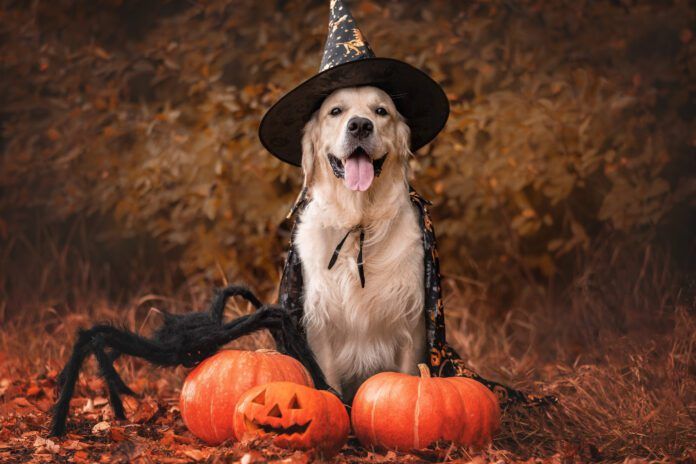It’s the season for costumes, candy, and creepy décor. Halloween can be one of the most fun holidays for a pet, but also one of the most hazardous. From choosing safe costumes to takeaways on trick or treating, the following Halloween pet safety tips will help both you and your dog have a frightfully delightful holiday.
Costume Parties for Dogs
Some dogs—Pugs, we’re looking at you—think dressing up is a blast, while others prefer to prance around in their birthday suit, or maybe a bandana if they’re feeling formal. The trick is to know where your dog falls on the costume continuum. Here’s what to consider when choosing Halloween costumes for dogs:
- Fit comes first. A happy Halloween dog needs to feel at ease in a costume. No matter how cute, avoid costumes that restrict vision, hearing, breathing, or movement. Skip costumes with buttons, bows, or fringe that can be chewed off and swallowed. Straps should be easily adjustable without catching on fur or dragging on the ground. A costume that glows in the dark or has reflective strips is a plus.
- Condition costume comfort. Don’t buy a costume the day before Halloween and expect your dog to take to it immediately. Start practicing putting it on a week or two beforehand, rewarding T-Rex or Twyla with treats and praise as you go and gradually increasing the length of time it stays on. Try it on them several times beforehand until getting it on is second nature for both of you by the time a party or pet costume parade rolls around.
- Watch for discomfort. Plenty of dogs love to strut their stuff in a costume, reveling in the attention it brings, but others aren’t fans, and it shows. Signs your dog isn’t having a good time include ears laid back, lowered head and tail, dilated pupils, and pawing to remove it. Don’t force the issue if your dog hates wearing a costume. That’s no fun for either of you. They’ll look just as cute in a pumpkin-themed bandana or even their own gorgeous fur coat.
- Photo op. Pets don’t have to wear costumes for long periods for you to get some great shots for social. Trade some treats for a short photo session and then let them go back to wearing their own fur suits.
What About Your Own Costume?
Your dog may be weirded out if you suddenly appear as Beetlejuice or Wednesday Addams. Let them watch you put on and take off the costume a couple of times—give treats as you do so—and become used to seeing you walk around the house in your new guise, especially if it involves a mask. My dog Harper freaked out every time I put on a mask, even one of those half masks on a stick, so if your dog doesn’t like masks either, try offering favorite treats or toys while wearing one to help develop a pleasant association with it, avoid staring at your pet while wearing it, or don’t wear it in their presence.
Dogs and Spooky Décor
Halloween is a great opportunity to practice conditioning your dog to giant inflatable decorations—because they’ll show up again in November and December. Other elements of spooky season your dog should become accustomed to are strobe lights, jack-o-lanterns, hanging decorations, glow-in-the-dark skulls, and electronic voices that emanate from scary figures when people—or dogs—walk by.
Hand out a favorite treat, toss a ball, or offer a game of tug as you introduce your dog to the new items in the home or yard. When puppy Harper was wary of approaching a large stack of trash bags containing grass cuttings, I sat on them, talked to her calmly, and tossed treats until she was ready to approach on her own. You can do something similar with a large inflatable or hanging figure. Don’t startle your dog by unexpectedly inflating it or dropping it down from a tree.
Gradually introduce other decorative items and use the same techniques to accustom your dog to their presence. Most dogs will adjust quickly after initially startling at the new object, but if they don’t, be patient in conditioning them.
Halloween Dog Safety Tips
Sweets, trick or treating, Houdini escapes, and candle flames are just a few of the Halloween hazards dogs face. Here are some Halloween pet safety tips to keep in mind:
Keep your dog choco-lonely. Most of us know that chocolate can have adverse effects on dogs. Gorging on candy, chocolate or otherwise, isn’t good for them. To avoid a canine bellyache, vomiting, diarrhea, or worse, place all candy well out of reach, even if your dog is a good boy or girl who would never! Sweets can tempt anyone beyond all reason.
Dogs who do find candy often swallow it whole, wrappers and all. If you’re lucky, they’ll just poop out gold foil for a few days, but wrappers can serve as linear foreign bodies that may block or damage the intestinal tract, causing serious problems that require surgical intervention. Be aware of signs of obstruction which include:
- Vomiting (abdominal heaving and production of partially digested food or other matter, often associated with obstruction of stomach or small intestine)
- Regurgitation (food isn’t swallowed and rolls back out of the mouth—seen with esophageal obstruction)
- Diarrhea
- Lethargy (listless, doesn’t seem to feel well)
- Appetite loss (especially in dogs who normally love to eat)
Read labels or ask about ingredients, even on foods that might seem harmless. Some candy, mints, gum, and peanut butter, along with sugar-free cookies, cakes, or other baked goods may contain a sugar substitute called xylitol (also seen on labels as birch sugar). It’s great for people who can’t have sugar, but deadly to dogs, causing a dangerous drop in blood glucose levels. Take dogs to the veterinarian or pet ER immediately if they eat anything containing xylitol.
Dogs may also try to snack on decorations such as fake eyeballs, cobwebs, glow sticks, and potpourri, to name just a few. If you have a dog whose mission in life is to taste-test everything they come across, place these items judiciously. All can pose a risk to your dog if ingested.
Having a party? Set out a bowl of pet-friendly treats for guests to give. Ask them to stick to those and not give your dog anything else.
Prevent escapes. After Independence Day, Halloween is the second most common time of year for pets to escape their homes. And that’s not surprising, given the number of times doors open and close for trick-or-treaters. Consider setting up a treat station in the yard so your dog doesn’t have a chance to slip out the door. You can also place a pet gate at the front door to prevent your dog from running out. Keep a bowl of small dog treats nearby, too, so you can reward your dog for good behavior when people are at the door.
Taking dogs trick-or-treating with the kids can be a fun twist on their regular walk, but it’s an opportunity for them to run off if they’re startled by a gaggle of ghosties and ghoulies. Be sure they have a good recall and are wearing a reflective vest or flashing collar or leash, as well as their normal identification tags and a microchip. Also consider going earlier in the evening, while there’s still some light.
Not all dogs are social animals or enjoy the sight of strange and wonderful beings—i.e., trick-or-treaters. If costumed revelers coming to the door are likely to make your dog howl in fear, set them up in an interior room away from the commotion with some treats and a favorite chew toy.
Fun Halloween Activities With Dogs
Besides putting them in costume, taking dogs trick-or-treating with you and the kids, or having them as costumed sidekicks at the door while you hand out candy, there are other fun ways to include dogs in the holiday. You can:
- Visit a pumpkin patch.
- Participate in a pet costume parade or contest if your dog has nice manners and enjoys attention.
- Make homemade pumpkin dog treats.
- Play treat hide and seek, placing treats around the house for your pet to find.
- Share slices of apple spread with peanut butter, squeeze cheese, or plain yogurt.
- Bob for treats.
Finally, if neither of you are fans of Halloween happenings, there’s nothing wrong with turning out the lights, snuggling on the sofa together, bowl of popcorn at hand, and streaming Hocus Pocus, Halloweentown, and Hotel Transylvania.






